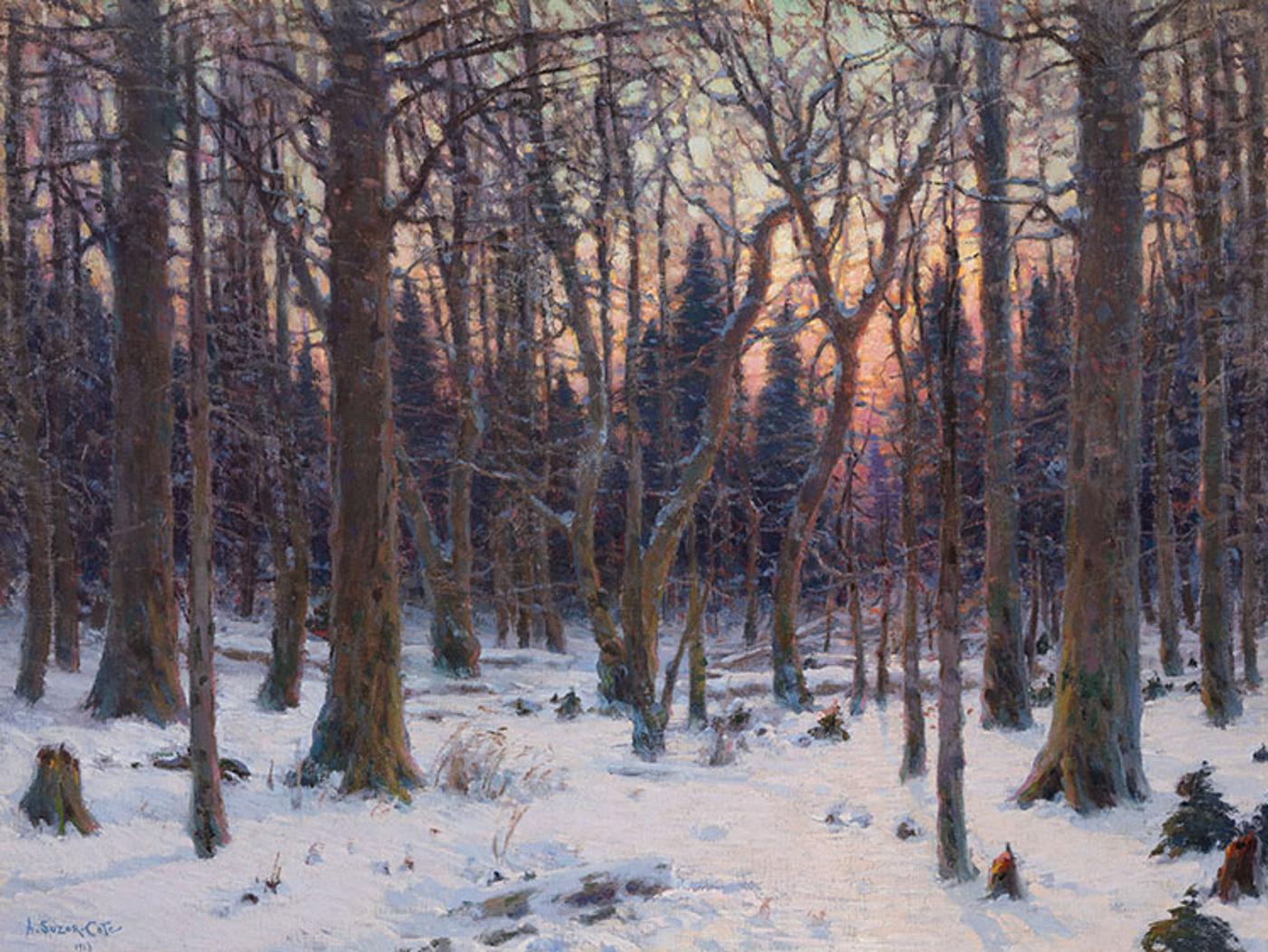
Winter Woodland Scene at Sunset, Arthabaska
68.59 cms x 91.4 cms (27 ins x 36 ins)
Signed and dated 1913 and on verso titled
made in 1913
Lot offered for sale by Heffel, Vancouver at the auction event "Canadian Impressionist & Modern Art (2nd session)" held on Thu, May 30, 2024.
Lot 433
Lot 433
Estimate: CAD $25,000 - $35,000
Realised: CAD $73,250
Realised: CAD $73,250
Lot description - from the online catalogue*
Provenance:
Dominion Gallery, Montreal
Private Collection, Montreal
Notes:
Marc-Aurèle Suzor-Coté was proud to have been born in the Quebec "village" of Arthabaska (now Victoriaville), and he painted numerous subjects inspired by Arthabaska and its first inhabitants. Upon his return from France – where he had lived on and off since 1891 – Marc-Aurèle Suzor-Coté spent most of his time as of July 1907 in the Arthabaska studio in his native village. It was here that he found inspiration for the paintings that would establish his fame, local scenes that would be well received nationally. Landscapes, portraits of peasants and genre scenes rendered in oil, charcoal, pastel and sculpture established his reputation, which would only grow with the constant exposure his work received at W. Scott & Sons. The National Gallery of Canada acquired his Settlement on the Hillside in 1909, the same year it was painted, while a collector from Brockville, the Honourable A.C. Hardy, acquired his masterpiece Winter Landscape (in collection of the National Gallery of Canada), also painted in 1909.
When in Paris, Suzor-Coté was trained as an academic painter at the École des beaux-arts and at the Académies Julian and Colarossi, and he produced a number of nudes that he could not easily sell in prudish Catholic Quebec. But he also met the landscape painter Henri Harpignies of the Barbizon School, who was a close friend of Jean-Baptiste-Camille Corot. Harpignies introduced him to pleinairism, the concept of painting in the open. While he was in France, the main influence Suzor-Coté absorbed was Impressionism. To paint snow was a challenge that French Impressionist Claude Monet took seriously. One of the first snow paintings he ever painted, The Magpie, 1868 – 1869 (in the collection of the Musée d’Orsay), depicted shadows on snow with blue rather than grey. This lesson was well understood by Suzor-Coté, as this canvas clearly attests with the blue shadows on the snow and the glowing sun vibrating through the branches of the trees.
This canvas is a loving depiction of Suzor-Coté’s homeland, which fully realizes the idea of "light and matter" suggested in the title of the 2002 retrospective of the painter’s work at the Musée du Québec. Snow, as always, is essential subject matter, and the warm glow of a Canadian winter sunset subtly illuminates each dappled surface.
Dominion Gallery, Montreal
Private Collection, Montreal
Notes:
Marc-Aurèle Suzor-Coté was proud to have been born in the Quebec "village" of Arthabaska (now Victoriaville), and he painted numerous subjects inspired by Arthabaska and its first inhabitants. Upon his return from France – where he had lived on and off since 1891 – Marc-Aurèle Suzor-Coté spent most of his time as of July 1907 in the Arthabaska studio in his native village. It was here that he found inspiration for the paintings that would establish his fame, local scenes that would be well received nationally. Landscapes, portraits of peasants and genre scenes rendered in oil, charcoal, pastel and sculpture established his reputation, which would only grow with the constant exposure his work received at W. Scott & Sons. The National Gallery of Canada acquired his Settlement on the Hillside in 1909, the same year it was painted, while a collector from Brockville, the Honourable A.C. Hardy, acquired his masterpiece Winter Landscape (in collection of the National Gallery of Canada), also painted in 1909.
When in Paris, Suzor-Coté was trained as an academic painter at the École des beaux-arts and at the Académies Julian and Colarossi, and he produced a number of nudes that he could not easily sell in prudish Catholic Quebec. But he also met the landscape painter Henri Harpignies of the Barbizon School, who was a close friend of Jean-Baptiste-Camille Corot. Harpignies introduced him to pleinairism, the concept of painting in the open. While he was in France, the main influence Suzor-Coté absorbed was Impressionism. To paint snow was a challenge that French Impressionist Claude Monet took seriously. One of the first snow paintings he ever painted, The Magpie, 1868 – 1869 (in the collection of the Musée d’Orsay), depicted shadows on snow with blue rather than grey. This lesson was well understood by Suzor-Coté, as this canvas clearly attests with the blue shadows on the snow and the glowing sun vibrating through the branches of the trees.
This canvas is a loving depiction of Suzor-Coté’s homeland, which fully realizes the idea of "light and matter" suggested in the title of the 2002 retrospective of the painter’s work at the Musée du Québec. Snow, as always, is essential subject matter, and the warm glow of a Canadian winter sunset subtly illuminates each dappled surface.
Most realised prices include the Buyer's Premium of 18-25%, but not the HST/GST Tax.
(*) Text and/or Image might be subject matter of Copyright. Check with Heffel auction house for permission to use.
(*) Text and/or Image might be subject matter of Copyright. Check with Heffel auction house for permission to use.